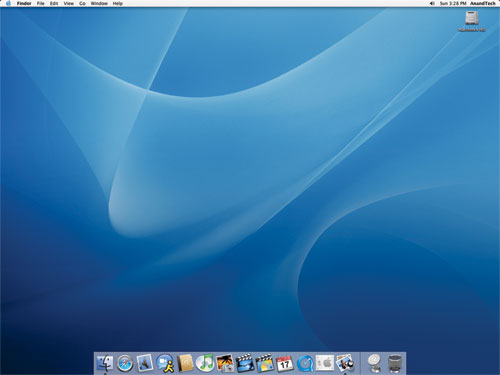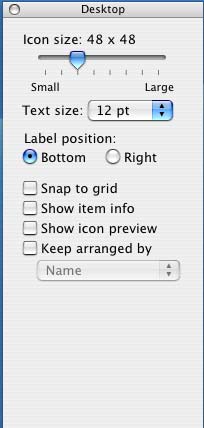A Month with a Mac: A Die-Hard PC User's Perspective
by Anand Lal Shimpi on October 8, 2004 12:05 AM EST- Posted in
- Mac
Finding my way around Finder
The OS X desktop is clearly different from what I was used to under XP. For starters, all of the icons have been moved to the right side of the screen; and where I was used to seeing a taskbar, there was this little translucent "dock" with a bunch of icons in it.
The OS X desktop and features, such as icon size, dock size and animations, are easily customizable.
Click to enlarge.
Under Windows, there is Explorer. It is the application that not only exists as a way of browsing your file system, but also as the "desktop" itself; the OS X equivalent? Finder. I don't think that I have to point out the similarity in the names. Yes, one company copied (or poked fun at) another.
My first reaction was that the icons on the desktop were far too large; indeed, they are, if you put them on a Windows desktop - but for some reason, they end up looking strange if you make them smaller. One of the biggest features of OS X is the ability to customize just about every aspect of the OS; I didn't like the size of the icons at first, so I simply changed the icon size through the "view options" menu. Although it's easy to talk about now, I had to ask how to do it online before I ever discovered the option - also the case with the majority of OS X, most of the power and customization of the OS remains hidden. I quickly realized that although Apple had targeted the entry level computer user with the interface of OS X, the OS was far more tailored to the power user in my opinion.

Where to start? Customization is much more possible (and easy to do) under OS X than any variant of Windows that I have ever encountered. Icon sizes are just the beginning; through the view options menu alone, you can change the positioning of the labels on the icons, the text size as well as the normal array of Windows options. And any changes you make here occur in real time - no clicking "OK" or "Apply". Just check a box and it happens instantaneously; and uncheck it, and everything goes back to normal. It's a small thing, but as I soon found out, much of OS X's appeal to me came in tiny gems like this.
The other thing to point out, which is quite possibly the biggest draw to OS X for me, is the fact that just about everything under OS X has a keyboard shortcut associated with it. I've found that if you got your start with PCs in the DOS days, then you end up being much more of a keyboard junkie than someone who is reliant on the mouse. I use the mouse when I have to, but when it's quicker to use the keyboard, I feel much more comfortable firing off a few keystroke combinations to get my point across. If you are anything like me in that respect, then OS X will be your playground.
I can't possibly list all of the keystroke combinations that I use on a daily basis, but there are quite a few. For example, I am a big "ALT-TAB"-er in Windows, but ALT-TAB is only really useful for switching applications, not closing them. The ALT-TAB equivalent under OS X, Command-TAB (the Command key is positioned where you'd expect ALT to be, so it works out fine), works similarly, but here's the catch - hit "Q" while you've selected an application and it will quit automatically. Nice, but nothing major right?
Want to minimize a window? Command-M will take care of that. Want to hide an application without minimizing it? Command-H. Hidden windows will automatically move to the end of the Command-TAB list, so you don't switch to them after you've hidden them.
Want to open a new Finder window? Command-N. Want to create a new folder on your drive? Shift-Command-N. I've always wanted to be able to create new folders in Explorer without using the mouse. OS X was a dream come true in that respect.
OS X will even let you define your own keyboard shortcuts for any application through the keyboard preferences panel:

Not impressed? Not a keyboard junkie? Then Finder is just as capable and as usable as Explorer. No big win for Apple there, but maybe a draw. For me, the little things are what intrigued me, but I'll admit - not everyone is as easily amused!
There is one aspect of the keyboard shortcut support that OS X does fall behind on, and that is support for keyboard shortcuts in dialog boxes. In some dialog boxes, hitting Command and the letter of the option you want to select will work, but in others, it will not. Furthermore, finding out the correct key to hit to select the option that you want is most definitely a guessing game, as there are no underlined characters or anything indicating what key to hit. Given OS X's strong support for keyboard shortcuts, this shortcoming (no pun intended) is puzzling.










215 Comments
View All Comments
webchimp - Friday, October 8, 2004 - link
When you compared multitasking performance on a Mac to a Windows PC, was the Windows PC also a dual processor machine?One of the major benefits of multiple processors is multitasking performance and it would be unfair to compare a single processor PC to a multi processor PC regardless of the particular CPU and OS.
insomn - Friday, October 8, 2004 - link
"When writing an article (especially big NDA launches), I'd have around 20 IE windows open"IE?
www.getfirefox.com
20 IE windows = 1 firefox window.
CindyRodriguez - Friday, October 8, 2004 - link
I'll try to only comment on the big stuff.Anand doesn't get the application install process at all. He's overthinking it way too much. Things don't have to be 'windows complicated' in OS X.
In a drag and drop install, you aren't copying the "Application Installer" over to the hard drive. You're actually copying the Application its self over.
Applications in OS X are actually bundles. They appear as binaries but they are actually directories with a hidden .app suffix on them. Select any OS X native App and control-click or rightclick on it. A contextual menu will pop up, select "Show Package Contents". This is the whole application.
Contrary to what Mr. Shimpi said, there is no process were files are auto-magically copied to hidden and forbiden regions of your hard drive when you copy an application bundle from the installer disk to your hard drive. The application is entirely selfcontained so you are actually dragging everything over in one fell swoop. There is no disconnect because what you see in the install is what you get, a simple copy. OS X bundles are actually incredibly elegant ways to package applications.
Some applications do require some additional files to be installed into the OS and this is where Anand was getting confused. Not all application installs in OS X are simple drag-drops. Many use more familiar installer shells. Some Drag and Drop installs also contain self repairing, Office is one example. Though the install is simply a copy, the application does require some files (like fonts for example) to be installed into the OS. This occurs when the application is first run, not when you copy the application over. On subsequent launches, if any of the required support files have been removed, they are reinstalled in much the same way. This is also a very nice feature.
Chuckles - Friday, October 8, 2004 - link
With regard to your trouble opening folders and applications using the keyboard:Command-o opens whatever you have highlighted. I had never heard of Command-Shift-Down Arrow opening stuff before this.
CindyRodriguez - Friday, October 8, 2004 - link
Argh.. I could only get through the first two pages before I was ready to pull my hair out.* The article is outdated even though it was published today. Apple rev'ed that machine in July.
* G5s are expensive but so are similarly configured PCs. A dual opteron or dual Xeon from a real vendor with a real warranty will cost you just as much or more than the G5. I've actually spec'ed out dual G5s next to dual Xeons and dual Opterons and contrary to what Mr. Shimpi says.. do don't get "much more". Do it your self everyone.. but remember that a dual 2GHz isn't a $3K computer anymore.
* Your overview of the Mac on page 2 is wrong. Apple didn't ship a Radeon 9600. The rev one shipped with a Radeon 9600Pro. That may seem like picking nits.. but I bet you'd consider is significant if I offered you a free 9600Pro or a free 9600 but not both.
* Anand tells us in Page 2 to look at the specs to see how mediocre they are.. but he forgets to remind us that this computer is a Rev 1, not a rev 2.
* Anand apparently didn't bother to look at Apple's new DVI monitors. He asserts that you loose the cable clutter cutting benefits of ADC but this isn't true. There is STILL only one cable to the DVI monitor. The cable breaks out to power/usb/dvi at the computer end.. in fact, Apple's new cable now includes firewire.
* Once again, to pick nits.. the mouse cable on an apple mouse is short to plug into the keyboard not the monitor. Apple keyboards have always had pass through ports for the mouse.
I'll try to trudge through the rest when I get time.. but it's pretty painful so far.
knutp - Friday, October 8, 2004 - link
Sure there is a 2004 version of the Office pacage. Remember that this is a version only suited for Mac OS.http://store.apple.com/1-800-MY-APPLE/WebObjects/A...
KutterMax - Friday, October 8, 2004 - link
One aspect not touched on in the review is some of the other applications included with the G5, that being iMovie, iPhoto, and iDVD.I'm a PC user but my wife has her own G5. She does a lot of work with digital photography and video and uses these apps a ton. They seem to work really well and integrate nicely together. $3000 is a lot to justify for a machine, but certainly these apps add some value. Further, an iMac G5, which would be about half the price, would also include these same apps and provides a little more value for the money (but only a single processor).
ksherman - Friday, October 8, 2004 - link
the current version of the MS Office is 2003, not 2004... But a very god article indeed... Though i dont think ill be slapping down $3000 down for anything except a down payment on a car! :) I do agree that the slow downs that exist are crazy, given such an expensive computer. The fact that over 1GB memory is practically REQUIRED is a bit of an annoyance. But thats the price for a sexy OS!sgd2z - Friday, October 8, 2004 - link
ThatGuyPSU - Friday, October 8, 2004 - link
Thanks, Provia. I realized that after I hit Post Comment. Regardless, MS Office 2004 for the PC doesn't exist and probably won't since we're just about at the end of 2004. If anything, you'll see an MS Office 2005.